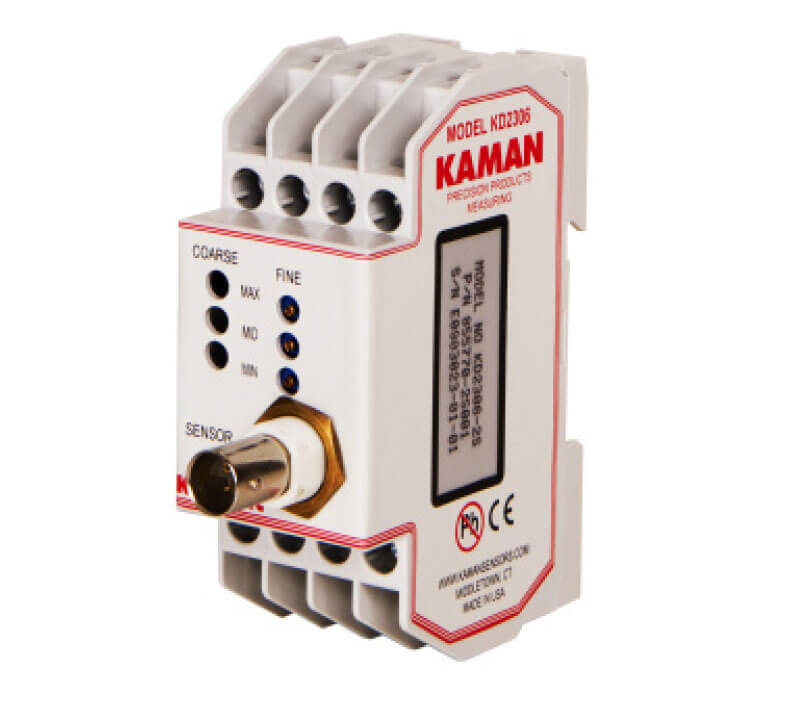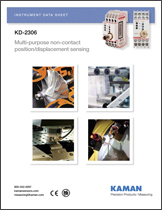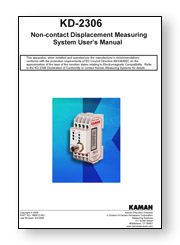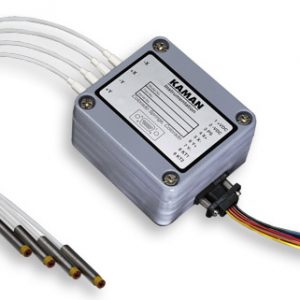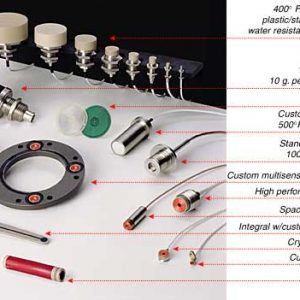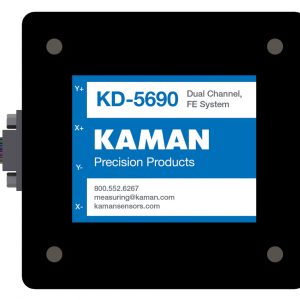KD-2306
Single-channel multi-purpose non-contact
displacement sensing system
- Supports both dual and single coil sensors
- Terminal I/O connections
- Auto-synchronization of multiple channels
- Analog DC and 4-20mA outputs
- Single ended, bipolar, and differential voltage outputs
- Front face coarse and fine calibration controls
- RoHS compliant and CE marked
- DIN rail configuration ideal for industrial, research and OEM applications
| Electronics | IGS format | STEP format |
|---|---|---|
| KD-2306 | IGS | STEP |
| KD-2306 | IGS format | STEP format |
|---|---|---|
| 2U sensor | IGS | STEP |
| 2UM sensor | IGS | STEP |
| 1S sensor | IGS | STEP |
| 1SM sensor | IGS | STEP |
| 1U1 sensor | IGS | STEP |
| 1SU sensor | IGS | STEP |
| 1SUM sensor | IGS | STEP |
| 2S1 sensor | IGS | STEP |
| 2UB1 sensor | IGS | STEP |
| 2S sensor | IGS | STEP |
| 3U1 sensor | IGS | STEP |
| 4S1 sensor | IGS | STEP |
| 4SB sensor | IGS | STEP |
| 6U1 sensor | IGS | STEP |
| 6C sensor | IGS | STEP |
| 8C sensor | IGS | STEP |
| 15U1 sensor | IGS | STEP |
| 10CU sensor | IGS | STEP |
| 30U1 sensor | IGS | STEP |
| 12CU sensor | IGS | STEP |
| 60U1 sensor | IGS | STEP |
| 1UEP sensor | IGS | STEP |
| 2SMT sensor | IGS | STEP |
| 9U sensor | IGS | STEP |
| 12U sensor | IGS | STEP |
| 16U sensor | IGS | STEP |
| 26U sensor | IGS | STEP |
| 38U sensor | IGS | STEP |
| 51U sensor | IGS | STEP |
The following specifications can be applied to the full range of systems using standard sensor options in the sensors chart. Each sensor has specific performance specifications that can be better than those listed below.
| Resolution | 0.01%FS |
| Frequency response | 50KHz (-3dB point) Higher response available on request. |
| Nonlinearity | <1%FS |
| Thermal sensitivity | Standard 0.1%FS/°F; compensated 0.02%FS/°F |
| Output options | 0-10 VDC (standard); 0-5 VDC ±5 VDC, 4-20 mA |
| Operating temperature range | Electronics +32°F to +132°F (0°C to +55°C) |
| Storage temperature range | Electronics -67°F to +220°F (-55°C to +105°C) |
| Power supply requirements | Voltage +15 to +30 Vdc Voltage regulation ±1/2 Vdc Current 150 mA |
STANDARD TEMPERATURE SENSORS
– 67° TO +220° F (–55° TO +105° C)
| SENSOR click to view | STANDARD MEASURING RANGE | TARGET MATERIAL | STATIC RESOLUTION |
|||
|---|---|---|---|---|---|---|
| inch | mm | non-fer | ferrous | μ in | μ m | |
| 2U / 2UM | 0.020 | 0.5 | 2U | 2UM | 4 | 0.1 |
| 1S / 1SM | 0.040 | 1.0 | 1S | 1SM | 4 | 0.1 |
| 1U1 | 0.040 | 1.0 | • | 4 | 0.1 | |
| 1SU / 1SUM | 0.050 | 1.3 | 1SU | 1SUM | 5 | 0.1 |
| 2S1 | 0.080 | 2.0 | • | 8 | 0.2 | |
| 2UB1 | 0.080 | 2.0 | • | 8 | 0.2 | |
| 2S | 0.100 | 2.5 | • | • | 10 | 0.3 |
| 3U1 | 0.120 | 3.0 | • | 12 | 0.3 | |
| 4S1 | 0.160 | 4.0 | • | • | 16 | 0.4 |
| 4SB | 0.160 | 4.0 | • | 16 | 0.4 | |
| 6U1 | 0.240 | 6.0 | • | • | 24 | 0.6 |
| 6C | 0.250 | 6.4 | • | • | 25 | 0.6 |
| 8C | 0.500 | 13 | • | • | 50 | 1.3 |
| 15U1 | 0.600 | 15 | • | 60 | 1.5 | |
| 10CU | 1.000 | 25 | • | • | 100 | 2.5 |
| 30U1 | 1.200 | 30 | • | • | 120 | 3.0 |
| 12CU | 2.000 | 50 | • | • | 200 | 5.0 |
| 60U1 | 2.400 | 60 | • | • | 240 | 6.0 |
MODERATE TEMPERATURE SENSORS:
CRYOGENIC TO +400° F (+200° C), SENSOR DEPENDENT
| SENSOR click to view | STANDARD MEASURING RANGE | TARGET MATERIAL | STATIC RESOLUTION |
|||
|---|---|---|---|---|---|---|
| inch | mm | non-fer | ferrous | μ in | μ m | |
| 1UEP | 0.040 | 1.0 | • | • | 4 | 0.1 |
| 2SMT | 0.100 | 2.5 | • | • | 10 | 0.3 |
| 6CMT | 0.250 | 6.4 | • | • | 25 | 0.6 |
| 9U | 0.160 | 4.0 | • | • | 16 | 0.4 |
| 12U | 0.200 | 5.0 | • | • | 20 | 0.5 |
| 16U | 0.320 | 8.0 | • | • | 32 | 0.8 |
| 26U | 0.500 | 12 | • | • | 50 | 1.2 |
| 38U | 0.750 | 20 | • | • | 75 | 2.0 |
| 51U | 1.000 | 25 | • | • | 100 | 2.5 |
KD-2306 non-contact linear proximity/displacement measuring system
Kaman Precision Products
Measuring & Memory Systems
217 Smith Street
Middletown, CT 06457
USA
Telephone 860-632-1000
Fax 860-632-4515
Council Directive 89/336/EEC as amended by Council Directive 92/31/EEC (EMC Directive)
Council Directive 73/23/EEC as amended by Council Directive 93/68/EEC (LVD Directive)
EN 61326-1:2006 – Industrial Electrical equipment for Measurement, Control and Laboratory Use – EMC
EN 55011:2007 – Class A Group 1 Radiated Emissions Requirements
EN 61010-1:2001 The KD-2306 unit requires the use of a limited energy power supply circuit per EN 61010-1:2001 Article 9.3. The KD-2306 does not use or switch voltages in excess of 60 VDC or 42.4 VAC peak (30 VAC rms).
Many options are available to customize a standard system to meet the exact needs of the application. The most popular are:
Most sensors can handle longer cable lengths, although increasing the cable length can and will affect some performance specifications. Shorter than standard cable lengths are also available. Call an apps engineer to discuss your particular requirements.
Many sensors come with integral sensor cables. Routing this cable in some applications is difficult and something you only want to do once. Including an in-line connector splice in the cable, near the sensor itself, allows for easy sensor replacement should the need arise.
Some applications pass the sensor through a pressure boundary, most commonly a vacuum chamber wall. We offer an in-line hermetic bulkhead splice for these applications.
Standard published ranges are based on meeting a set of performance specs. Custom calibrations are possible to meet specific application needs. Contact a Kaman applications engineer if a custom calibration is desired.
Unless otherwise specified, nonferrous systems will be calibrated with an aluminum target, ferrous systems will be calibrated with a 4130 steel target. If your target material is significantly different in conductivity and/or permeability it may be best to calibrate using the same material as your target.
When the standard thermal sensitivity of 0.1%FS/°F is not enough, a temperature compensated calibration can be performed that will improve the thermal sensitivity to 0.02%FS/°F. This is accomplished over a customer specified 100°F range with the upper limit of that range <150°F. Larger ranges and higher temperatures are also possible on a best effort basis.
Besides the standard 0-10VDC output, the KD-2306 offers a 4-20mA output and a differential 0-10VDC output.
When multiple channels are used in such a way that the sensors themselves are in close proximity to each other (within 3 sensor diameters), synchronizing the oscillators of the electronics modules will eliminate the resulting beat note interference that will be seen as noise on the outputs.
When extremely short range calibrations are required/desired, bypassing the log amplifier reduces noise improving performance.

